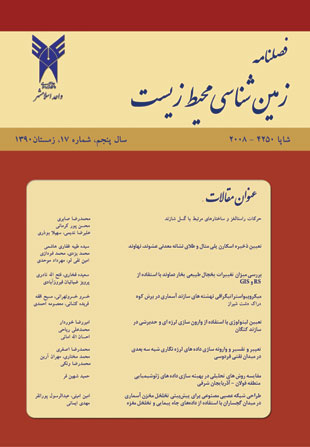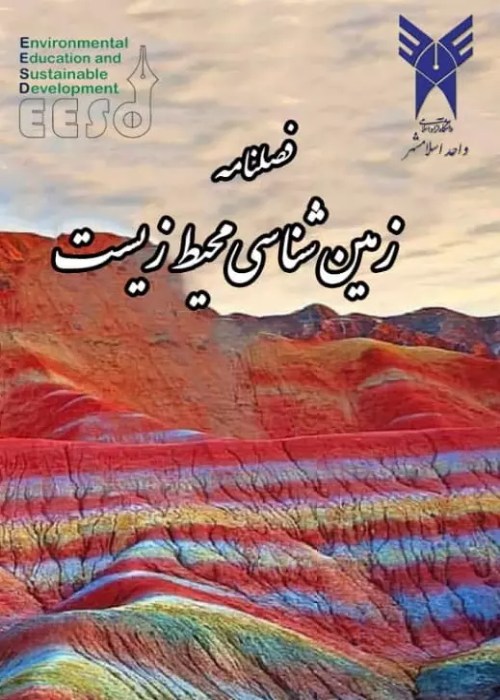فهرست مطالب

نشریه زمین شناسی محیط زیست
پیاپی 17 (زمستان 1390)
- تاریخ انتشار: 1391/02/15
- تعداد عناوین: 8
-
Page 1The region of Khersan 1-5 dam is in Chaharmahal-Bakhtiari province. It is located 45 km west of Lordegan city.The reported earthquakes in this region are low depth type and have a focal depth less than 15 km. They also have no surface failure. The seismic hazard analysis illustrates the nature of seismicity of the site and is evaluated according to dispersion, fault type, morphology of faults, and past earthquakes data. Here, using tectonic maps of the site, arial and satellites photos, and the seismic data of the site, it have been tried that the seismicity of the site to be determined. Bazoft and Massan faults with 45 and 36 km length are the nearest faults to the site. When they become active, they can provide an earth quake as big as M=7.0 and 6.9 Richters,respectively. Bazoft and Massan faults have the ability to provide the MCLs as big as 0.269g, 0.222g,respectively.According to probabilistic seismic hazard analysis in the site, for return periods of 150, 475 and 2000 years, and according to Bender & Perkins (1987) method, and using (Seisrisk III) software, accelerations equal to 0.261g, 0.291g, and 0.310g, for the center of zone, are calculated respectively.Keywords: Strike, slip fault, Zagros Orogen, Shazand fault, Golpayegan
-
Page 15Oshvand Poly Metal Skarn is located 15 km East Nahavand. The index is the first metal index sheet 1:100,000 Nahavand which is unique according to the dimensions, carat, and typical of skarn type. Of Geology, Oshvand area is part of Sanandaj – Sirjan zone; Oshvand Skarn is composed of penetrating a granite mass of upper Cretaceous age into Paleozoic limestone. Mineral is exposed in two sections, Exo-skarn and Endo-skarn approximately 300 meters long and 65-91 meters wide and 40 meters height.Store is composed more in the east of skarn,, copper and iron carat was significant in all samples of skarn, and their Average carat is seriate 3439ppm and 105273ppm, So for determine the deposit was used Blocking technique because obtained nearest actual tonnage. After estimating storage can expect potential more than 119 kilograms of gold, 1,717.5 tons zinc 9,574 tonnes of copper and 296,355 tons of iron.Keywords: Polymetal skarn, Gold, Mineralization, Oshvand, Nahavand
-
Page 29Natural glaciers as one of the main surface water resources are of a significant importance in the recent time.Remote sensing technology is an important tool in locating and estimating the area of the regions covered with ice and snow especially in the out- of- reach mountainous regions. Identifying the morphodynamic changes by means of remote sensing is an essential requirement of the management and assessment of natural resources; one of its methods is to provide the map of changes according to remote sensing images and to use the Geomatica soft ware. We chose Damavand Yakhar glacier due to its activity and morphodynamic changes during the recent years. To discover the changes, we used calculation algorithm for changes intensity by subtracting parallel bands on satellite images and principle component analysis (PCA). Finally we located the hydrothermal areas in the glacier by extracting line mentums and combining different bands of TM and ETM scanners in geomatica software. The results of this research show that the area of Yakhar glacier is retreating and its present size is 1.8km2.The main causes of its retreat are the decline of glacier recharge and the heat of smoke emerging fromDamavand volcano.Keywords: Morphodynamic changes, Remote sensing, Geomatica, Fuzzy logic, Yakhar
-
Page 39This study concentrates on biostratigraphy Asmari Formation on Derak section that is located at Shiraz city with 333.5 meter thickness. Asmari Formation in this section comprises of limestone with marlyinterbedded.Asmari Formation trasitionally overlies the Jahrum Formation and underlies the Razak Formation. 3 lithologic units identified within the Asmari Formation in this section. In the Micropaleontological study, Asmari Formation at Derak section led to identify 31 genera and 38 species benthic foraminifera. Therfore, in this study the base of biostratigraphy is on benthic foraminifera. In biostratigraphy study, Wynd s report (1965) and Adams and Bourgeois (1967) report are such as pattern. The first appearance of Archaiasasmaricus and Meandropsinaanahensisand Peneroplisthomasi show the boundary between Oligocene (chattian)-Miocene (Aquetanian). Biozone no. 1 is comparable to biozone no. 2 Adams and Bourgeois(1967) and biozone no. 59 Wynd(1965) and middelASmari in Thomas (1949) report.Biozone no. 2 identified with appearance of Nummulitesfichteli,N.intermediusalso in this zone there is Archaiasoperculiniformis. Biozone no.2 is synonymous with biozone no. 3 Adams and Bourgeois (1967) and biozone no. 57, 58 Wynd (1965). Finally,the biozone no. 2 show Oligocene and synonymeous with lower Asmari of Thomas (1949).Keywords: Asmari formation, Derak montion, Benthic foraminifera, Biostratigraphy
-
Page 51The main objective of this study is to determine lithology of one of the hydrocarbon reservoir in southern Iran.In this study facies has been computed at each one of wells and facies of the most similar to lithofacies reservoir layers are used for Modeling. For this purpose at the first one acoustic impedance was modeled and a facies model in each of the wells with seismic inversion methods on the model (Model Based) using non-regulatory methods, neural network has been calculated.Comparison among these models showed that using cut off for determining Electro Facies and modeling them with Geostatistical gives better results than using of unsupervised neural network method for determining Electro Facies.Keywords: Seismic inversion, Acoustic impedance, Cut, off, Electro facies
-
Page 61The study has been done on "Ferdowsi" oil field located on Persian Gulf.Geological studies show that the north slope of the field has been situated along the Arabian shield in which its structure has been affected by the salt mass.Fahliyan formation is the main reservoir in the field. In order to interpret seismic data, firstly by using sonic and density logs, synthetic wavelet was constructed and compared to pseudo 3D seismic data using software.Then formation tops were picked, time and depth maps were prepared.Acoustic Impedance pseudo 3D volumes were performed by preparing seismic Inversion.It is to note that seismic attributes help greatly to estimate reservoir properties of target formation and it is useful in better identifying the reservoir and drilling wells with reduced cost impact.In addition, faults, stratigraphic features (such as channel) by seismic attributes were recognized in current study that is important for development of the field.Keywords: Seismic Interpretation, Seismic Inversion, Stratigraphic, Feature, Synthetic wavelet
-
Comparative study of analytical methods in geochemical data optimization, Ghoulan area, E-AzarbaijanPage 75Detection of optimized geochemical patterns requires Orientation Survey (O.S.) in which one of its important layers is selecting an effective data analysis method.In order to detect favorable potentials in Ghoulan area, discrimination of mineralized and blind ore zones using advanced techniques with presenting a suitable geochemical pattern and relative pathfinders is the scope of this study. In this respect, 233 stream sediment samples were collected from the area and analyzed for base metals (Cu, Mo, Cr, Co, Ni, Pb, Zn, As, Y …) and their indicator elements.The anomalous zones in the area were detected using two systemic methods such as principal component analysis (PCA) and Fractal (F) methods. Application of F method on geochemical data leads to detection of two anomalous zones of Cu in Gharachilar and W-Loutkeh, with Mo appearance in Namnigh. The separation of these two anomalous zones (Cu& Mo) probably is due to acidity of area formed by solubility of sulphides from outcrops and migration of Mo in the form of molibdate which caused the precipitation of Cu and Mo in two different zones.The results show that both methods (F&PCA) have similar detection zones but the capability of PCA inenhancement of halos and detection of blind ore zones is more effective than F method. As in this case, it could detect strong blind anomalous zone of Mo in Namnigh in addition to Cu & Mo trend. Overall, thecharacterization of methods also revealed that the PCA is more reliable in rejecting the syngenetic effects and the results can be more precisely used in the area.Keywords: Geochemical patterns, Favorable potentials, PCA, Fractal method, Ghoulan area


